
Church Canyon, Jemez Mountains
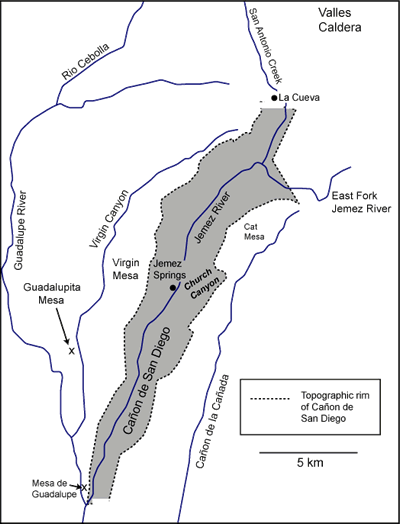
Spectacular exposures of Permian Yeso Group overlain by tilted and faulted late Oligocene to Pleistocene sedimentary and volcanic rocks are preserved at the head of Church Canyon to the east of Jemez Springs in Cañon de San Diego in the southwestern Jemez Mountains (Figure 1). This area is on private land owned by the Catholic Church; therefore, permission must be obtained from the church offices in Jemez Springs before visiting these outcrops.
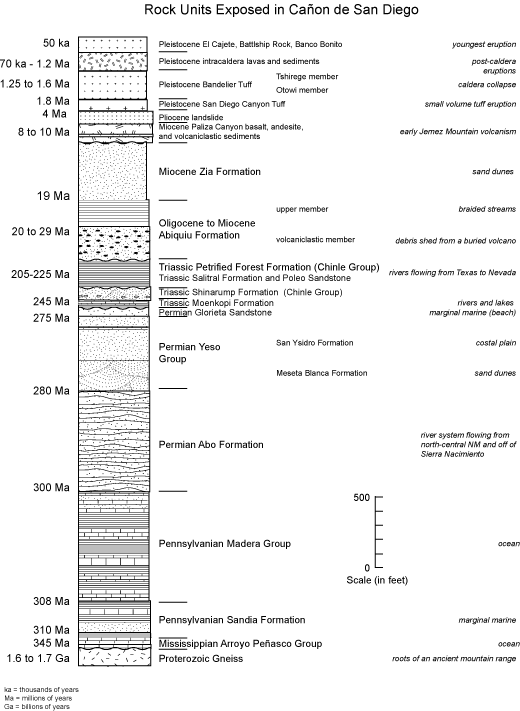
As mentioned in the discussion of Jemez State Monument, rocks exposed at the mouth of Church Canyon include the fossiliferous limestone and shale of the Pennsylvanian Madera Group and the red siltstone and arkosic channel sandstone deposits of the Permian Abo Formation (Figure 2). These rocks record the gradual transition from deposition in a shallow ocean during late Pennsylvanian time to deposition in a meandering river system with headwaters to the west and northeast of the area as the seas retreated to the south during Permian time.
The Abo Formation is overlain by orange-red siltstone and sandstone of the Permian Yeso Group high in the canyon wall to the east of the monument (Figures 2 and 3). The basal unit of the Yeso Group, the De Chelley Formation, is a reddish-orange medium to thick-bedded tabular sandstone with thin shale interbeds, occasional fluvial channel structures, and rare mudcracks. This sandstone is overlain by a distinctive eolian (wind-blown) sandstone characterized by meter-scale, tabular-planar, wedge-planar and trough cross-beds that record a paleo-transport direction generally to the south (Stanesco, 1991). The San Ysidro Formation of the Yeso Group, which overlies the De Chelley Formation, is primarily medium-bedded, tabular sandstone that is orange red near the base and red near the top. This unit is thin to absent at Church Canyon.
The Permian Glorieta Sandstone, as well as the Triassic Moenkopi Formation and Chinle Group, are exposed in southern Cañon de San Diego between Jemez Pueblo and Jemez Springs and to the east of a major fault exposed along the East Fork of the Jemez River (Kelley et al., 2003; Osburn et al., 2002), but these rock units are missing at Church Canyon. Here, the late Oligocene to early Miocene Abiquiu Formation sits directly on Permian Yeso Formation (Figures 3 and 4). The late Permian to Triassic rocks were likely removed during the compressional Laramide mountain building event about 75 to 55 million years ago.
The white tabular sandstone of the Abiquiu Formation in the Jemez Mountains is part of a volcaniclastic apron shed from Oligocene to Miocene volcanic centers located north of the Jemez Mountains (e.g., Latir volcanic field, Smith et al., 2002). The Abiquiu Formation in Church Canyon is underlain by a thin (<2 feet thick) gravel that contains a mixture of rounded volcanic gravel of uncertain origin and rounded Proterozoic granite and quartzite. The distribution of the gravels below the Abiquiu Formation in the southwestern Jemez Mountains seems to suggest an origin to the south, perhaps from a Oligocene to Miocene volcanic center buried beneath the southern Jemez Mountains or the northern Albuqueruqe basin (Kelley and Connell, 2004).
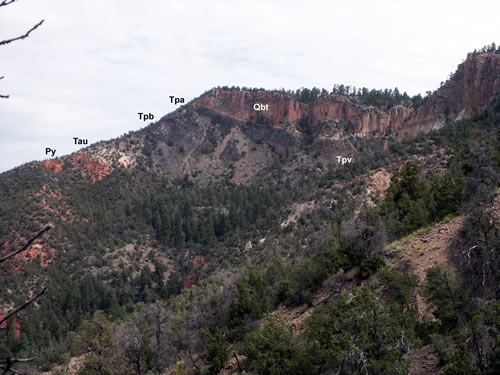
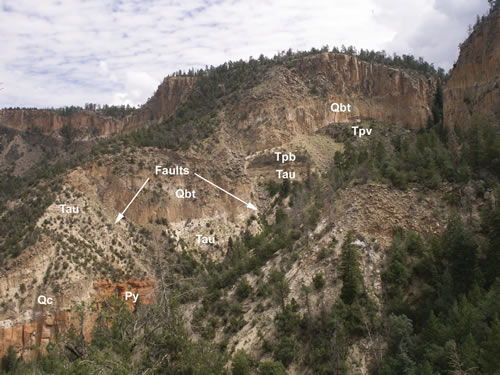
Two basalt flows, one with abundant olivine phenocrysts (small crystals in a fine-grained groundmass) and one with abundant plagioclase feldspar phenocrysts, overlie the Abiquiu Formation (Figures 3 and 4). Similar basalts to the south yield 40Ar/39Ar ages of 9 to 10 million years old (Osburn et al., 2002). An andesite overlies the basalt; similar andesites to the south are 8 to 9 million years old (Gardner et al., 1986). These lava flows are interbedded with fluvial volcaniclastic sediments (stream deposits shed off of volcanos) that contain rounded basalt and andesite clasts derived from the early Jemez Mountain volcanic field. The entire succession of lava and sediment is called the Paliza Canyon Formation (Smith and Lavine, 1996).
The older rock units are overlain by the 1.61 million year old Otowi (Tewa word for “gap where the water sinks”; Martin, 1998) Member and the 1.25 million year old Tshirege Member of the Bandelier Tuff. Otowi Memeber tuff is preserved in the head of Church Canyon, but most of the tuff shown in the photographs in this article are Tshirege Member tuff. The Otowi Member tuff is made of pumice, ash, crystals of quartz and sanidine, and dark-colored (black to brown) rock fragments that were violently erupted from the Toledo caldera. The Tshirege (pronounced shur-gay, Tewa word for “bird place”; Martin, 1998) Member of the Bandelier Tuff overlies the Otowi Member and was erupted from the Valles caldera. The Tshirege Member is similar in overall composition, but contains fewer rock fragments. In this area, the two tuffs are separated by about 1-2 m (3-6 ft) of Tsankawi (Tewa word for “gap of the sharp, round cactus”, Martin, 1998) Pumice Bed tephra, which was deposited during beginning phase of the younger Tshirege eruption. The Tshirege fills in a rugged paleotopography that developed on the Otowi during the 350,000 years between eruptions (e.g., Figure 5).
A thin tuff interbedded with volcaniclastic sediments below the Tshirege Member tuff cliff at the head of Church Canyon (Figure 6) may be the 1.8 million year old San Diego Canyon Tuff, a small volume eruption that occurred before the formation of the Valles caldera (Spell et al., 1990). Further analysis is needed to determine the identity of this tuff.
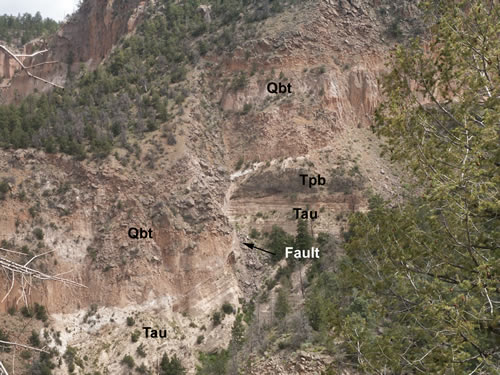

References
- Gardner, J.N., Goff, E, Garcia, S., and Hagan, R.C., 1986, Stratigraphic relations and lithologic variations in the Jemez volcanic field, New Mexico: Journal of Geophysical Research, v. 91, p. 1763-1778.
- Kelley, S.A., and Connell, S.D., 2004, Stratigraphy and tectonic implications of Oligocene-Miocene rocks in the southwestern Jemez Mountains, New Mexico: New Mexico Geology, v. 26, p. 66.
- Kelley, S.A., Osburn, G.R., and Kempter, K.A., 2007, Geology of Cañon de San Diego, southwestern Jemez Mountains, north-central New Mexico: New Mexico Geological Society Guidebook 58, p. 169-181.
- Kelley, S.A., Kempter, K.A., Goff, F., Rampey, M., Osburn, G.R., and Ferguson, C.A., 2003, Geology of the Jemez Springs 7.5 minute quadrangle, Sandoval County, New Mexico: New Mexico Bureau of Geology and Mineral Resources Open-file Geologic Map OF-GM73, scale 1:24,000.
- Martin, C., 1998, Los Alamos place names: Los Alamos Historical Society, Los Alamos, New Mexico, 126 pp.
- Osburn, G. R., S. Kelley, M. Rampey, and C.A. Ferguson, 2002, Geology of the Ponderosa 7.5-minute quadrangle, Sandoval County, New Mexico: New Mexico Bureau of Geology and Mineral Resources Open-file Geologic Map OF-GM57a, scale 1:24,000.
- Smith, G.A., and Lavine, A., 1996, What is the Cochiti Formation?: New Mexico Geological Society 47th Field Conference Guidebook, p. 219-224.
- Smith, G.A., Moore, J.D., and McIntosh, W.C., 2002, Assessing roles of volcanism and basin subsidence in causing Oligocene-lower Miocene sedimentation in the northern Rio Grande rift, New Mexico, USA: Journal of Sedimentary Research, v. 72, p. 836-848.
- Spell, T.L., Harrison, T.M., and Wolff, J.A., 1990, 40Ar/ 39Ar dating of the Bandelier Tuff and San Diego Canyon ignimbrites, Jemez Mountains, New Mexico: Temporal constraints on magmatic evolution: Journal of Volcanology and Geothermal Research, v. 43, p.175-193.
- Stanesco, J.D., 1991, Sedimentology and depositional environments of the lower Permian Yeso formation, northwestern New Mexico: U.S. Geological Survey Bulletin 1808-M, p. M1-M12.


